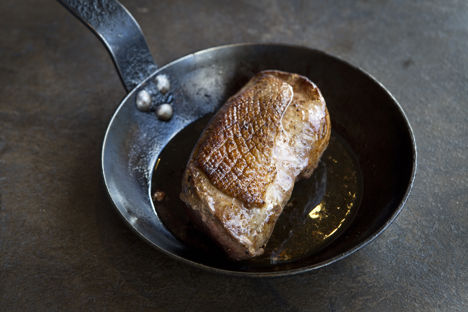"Christmas is coming and the goose is getting fat" – and that's not even because he's being force fed. It's a natural part of the goose's lifecycle, almost like the bird was designed for the Christmas table.
Goslings hatch in spring, and immediately start pecking away at grass, then wheat and maize. Around nine months old, they are ready for the table. There's no marketing campaign, no media strategy behind The Christmas Goose. It is, quite simply, the right time of the year to be eating this magnificent bird.
Centuries before turkeys usurped the goose as the Christmas centrepiece, they were the bird of choice at winter solstice feasts. In medieval England, the church sold ready-cooked geese to the poor at Christmas, for the fixed price of 7 pence, or 6 pence for an uncooked goose – roughly the equivalent of a day's wage. And there's no forgetting the sheer joy that a goose brought the Cratchits in Dickens' A Christmas Carol:
"At last the dishes were set on, and grace was said. It was succeeded by a breathless pause, as Mrs Cratchit, looking slowly all along the carving-knife, prepared to plunge it in the breast; but when she did, and when the long expected gush of stuffing issued forth, one murmur of delight arose all round the board, and even Tiny Tim, excited by the two young Cratchits, beat on the table with the handle of his knife, and feebly cried Hurrah!"
In 1526, it's thought that Yorkshireman William Strickland was the first person to bring a turkey to the British shores, having bought it from American-Indian traders. For centuries turkeys were an almost unobtainable luxury - in the 1930s it took a week's wage to buy a turkey. In the 1950s, they became more affordable – it now takes the equivalent of 1.7 hours' work to buy a turkey – which is why it is the centrepiece of 76% of Christmas spreads in the UK.
So where does this leave the poor goose? Despite being deeply-entrenched in British history, the bird is now more closely-associated with France, where it is linked to the foie gras controversy. Geese are slowly making a culinary comeback though, as chefs look to the past for inspiration. Goose meat is darker than turkey meat, with a touch of gaminess. They are usually a little smaller than turkeys, but with average birds weighing around 5-6kg, they are still big enough to comfortably feed a family of 6-8 people.
What to look for when buying goose
As there is a rush on geese around Christmas, it's best to order early. Although more and more supermarkets now stock geese, online retailers come with the advantage of pre-ordering and delivery.
When picking delivery dates, it's worth considering whether the goose can be stored in a home refrigerator or freezer. While a chest freezer should be fine, a stand-up freezer might not accommodate a 6kg goose. Defrosting guidelines should be on the packaging, but a good rule is that a frozen goose will defrost around the rate of 3-4 hours per kg in a cool room (17°C). So if you can arrange the delivery of a 6kg frozen goose 24 hours before it needs cooking, then there won't be any need to create room in the fridge or freezer. Make sure that the giblets are removed from the goose's cavity and put in the fridge. And, of course, that the "defrosting room" is cat-, dog- and fox-proof.
A small goose comes in at 4.5kg and will feed four people. A goose weighing 5 - 5.5kg will feed six to eight people, and an extra-large goose weighing 6kg will feed eight or more.
How to cook goose
The traditional way to cook goose is to roast it – a process which will take at least a couple of hours - until the skin is crispy and the meat is cooked through. Cooking times are affected by the size of the bird and whether or not it is filled with stuffing. Negotiating the large quantities of fat that emerge from geese during roasting is a key point to remember - Martin Wishart's roast goose recipe presents a thorough guide to removing fat, basting the bird and achieving beautiful crispy skin.
There are alternative methods which cut-down cooking times. Adam Byatt, for example, reduces oven time by just cooking the crown, and Simon Rogan minces the goose meat to make goose and chestnut chipolatas.
Goose legs and thighs should be slowly braised. The goose fat can be rendered after roasting or braising – skim away any impurities, strain the liquid through muslin, then store the goose fat for making confit goose leg or the ultimate roast potatoes.
What goose goes with
Goose is quite a rich and gamey bird, therefore fruit sauce is a great accompaniment. Apple sauce, plum sauce or even a festive cranberry sauce sit happily alongside goose on the plate. Don't shy away from Medieval sweet fruits either like prunes, figs, currants, chestnuts or dried apricots, for a traditional twist.
Get in touch
Please sign in or register to send a comment to Great British Chefs.



